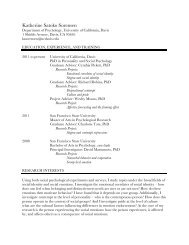SMART Board User's Guide - Psychology
SMART Board User's Guide - Psychology
SMART Board User's Guide - Psychology
Create successful ePaper yourself
Turn your PDF publications into a flip-book with our unique Google optimized e-Paper software.
Win<br />
Win<br />
7 Specify the page image resolution for the image files.<br />
8 Press Finish.<br />
9 To view the images you just created, go to the folder and open the desired page file.<br />
To save a Notebook file in HTML format (Windows operating systems<br />
only):<br />
1 Select Save As HTML from the File menu.<br />
2 Specify a directory for the HTML files by pressing the Browse button and navigating to<br />
an appropriate directory location. The default directory is My Documents on your hard<br />
drive. However, we recommend that you create a new folder to hold all your HTML<br />
files. If you enter the name of a folder that doesn’t yet exist, you’ll be asked if you want<br />
to create a new folder.<br />
3 If you have Microsoft Internet Explorer 4.0 or later and the Web Publishing Wizard<br />
installed on your system, you can select Publish Files to Web Server check box to<br />
publish the HTML files to a Web server. The Web Publishing Wizard will appear after<br />
you’ve completed the sequence of Save As HTML dialog boxes.<br />
4 Press the Next button.<br />
5 Specify a file name that will serve as the name of the main HTML file folder. This folder<br />
and an accompanying .html file will be created in the directory specified in step 2.<br />
NOTE: When naming an HTML file folder, avoid using spaces or special characters<br />
such as #,$,%,^,&,*,@,’, !, .<br />
6 Press the Next button.<br />
7 Specify the page image resolution for the HTML files, then press the Finish button.<br />
NOTE: If you’ve selected Publish Files to Web Server, the Microsoft Web Publishing<br />
Wizard will appear to assist you with the process of publishing the HTML files to a Web<br />
server.<br />
8 To view the HTML file you’ve just created, go to the directory specified in step 2, and<br />
open the .html file. Do not open the HTML folder; rather, double-press on the .html file<br />
associated with the folder.<br />
You can view the HTML version of your Notebook file using the Page Sorter or Normal<br />
view, and you can navigate through the file using the Back and Next buttons.<br />
9 The HTML folder and its accompanying HTML file can be put on a local area network<br />
drive for viewing with a Web browser.<br />
To save a Notebook file as a PDF file (Windows operating systems<br />
only):<br />
1 Select Save As PDF from the File menu.<br />
The Save As dialog box will appear.<br />
2 Use the current directory, or press the scroll arrow in the Save in box and select a<br />
different one.<br />
3 In the File name box, type a name, using the .pdf file extension.<br />
4 Press Save.<br />
To save a Notebook file as a template file (Windows operating<br />
systems only):<br />
1 Create your page as you want it to appear when inserted into another Notebook file.<br />
Consider making objects part of the background or grouping certain objects together.<br />
58 <strong>SMART</strong> <strong>Board</strong> User’s <strong>Guide</strong>
















